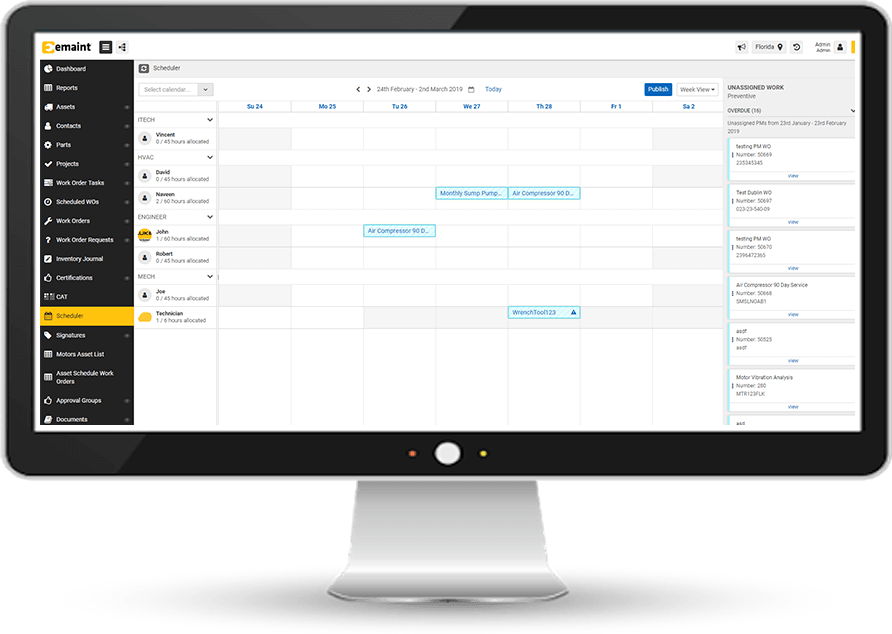What Is Scheduled Maintenance?
Scheduled maintenance is any planned repair or service task performed within a specified timeframe. This includes routine inspections, adjustments, and regular servicing, as well as planned shutdowns. Scheduled maintenance can be recurring, performed at regular intervals, or be triggered by a specific work request. It is designed to proactively address potential issues, ensuring efficient and timely upkeep of equipment and systems.
The actual task is only one part of scheduled maintenance. Who completes the task, where it takes place, and how long it takes are all crucial parts of the maintenance schedule. Even if you know what needs to be repaired, you still need to pick the best person for the job and the optimal time to do it. All of this can be a headache to keep track of without proper organization. That is why truly optimized scheduled maintenance requires a CMMS, or Computerized Maintenance Management System, to help manage work orders, assets, maintenance tasks, and more.
Why Schedule Maintenance?
We’ll go into the benefits of scheduled maintenance in detail below. But briefly, the key reasons to schedule maintenance are:
- To prevent costly breakdowns
- To reduce downtime
- Extend equipment lifespan
- Improve efficiency
- Maximize safety
- Ensure compliance
- Mitigate emergency repair costs
- Optimize resource output
What Is the Difference Between Planned Maintenance and Scheduled Maintenance?
The terms planned maintenance and scheduled maintenance are often used interchangeably, but they are two different things, even if they are both examples of preventive maintenance. A comprehensive asset maintenance strategy requires planned and scheduled maintenance working in tandem.
Planned maintenance is the process of forecasting or anticipating asset maintenance requirements and strategically planning future maintenance. Planned maintenance is an overarching term that encompasses preventative maintenance, predictive maintenance, and condition-based maintenance strategies.
Scheduled maintenance is the process of determining who should complete maintenance tasks and when they should be completed. Rather than forecasting future maintenance needs, scheduled maintenance focuses on resolving issues that have already been identified, assigning a worker to the task, and setting a deadline for task completion.
What Are the Types of Scheduled Maintenance?
Scheduled maintenance is a crucial aspect of effective asset management, ensuring equipment reliability and operational efficiency. There are several core types of maintenance, each serving a unique purpose in maintaining equipment health and changing the way tasks are scheduled.
Understanding these types of maintenance helps organizations implement a tailored maintenance strategy that optimizes equipment performance and reduces cost. It allows for scheduled maintenance that meets the precise needs of the operation. All without wasting time scheduling unnecessary tasks or last-minute repairs after downtime has already started.
Here are the primary types of maintenance:
Time-Based Maintenance
Maintenance activities are scheduled at regular, predefined intervals (e.g., weekly, monthly, quarterly). An example of this would be regular oil changes in machinery every three months to ensure optimal performance. Time-based maintenance takes the guesswork out of maintenance scheduling. There are set dates when tasks must be completed, and a schedule can be built around that. This type of maintenance prevents unexpected breakdowns and prolongs equipment lifespan.
Usage-Based Maintenance
Maintenance tasks are triggered based on usage metrics (e.g., operating hours, production cycles). For example, replacing HVAC system filters after 1,000 hours of operation. Usage-based maintenance requires a bit more data than time-based maintenance, as the usage of each individual asset must be closely monitored. This ultimately makes scheduling more efficient as it helps align maintenance activities with actual equipment usage, reducing unnecessary maintenance.
Predictive Maintenance (PdM)
Predictive maintenance uses real-time data and advanced analytics to predict when maintenance should be performed. An example of this would be using vibration analysis on rotating equipment to detect early signs of wear and schedule maintenance before failure. More recently, AI has been integrated to further enhance insight quality. Scheduling with a predictive model minimizes downtime and maximizes asset availability by addressing issues before they escalate.
Condition-Based Maintenance (CBM)
Maintenance is performed based on the actual condition of the equipment, often monitored through sensors and diagnostic tools. An example of this would be performing maintenance on a generator only when data indicates it’s operating outside of normal parameters. This allows scheduling to focus resources on equipment that truly needs attention and reduces time spent working on machines that have no irregularities.
What Is Factory Scheduled Maintenance?
Factory scheduled maintenance — a form of time-based maintenance — is a good example of recurring scheduled maintenance. It involves checking for potential problems while performing routine maintenance at set intervals. Most consumer vehicles require service at set mileage intervals to keep them running to the manufacturer’s specifications and keep warranties active. Similarly, each piece of equipment will come with a recommended maintenance schedule from the manufacturer.
While forgoing factory scheduled maintenance may seem like an opportunity to reduce expenses, routine maintenance inspections can be essential to finding and resolving problems early. As a result, keeping assets up to date with factory-recommended maintenance may actually save costs in the long run. (Of course, condition-based maintenance may be an even better approach if properly implemented.)
What Are the Benefits of Scheduled Maintenance?
Scheduled maintenance guarantees reliable asset performance and reduces unplanned downtime by keeping equipment in good working condition. It also helps you identify issues before they escalate to failure or shutdown. Proper scheduled maintenance extends asset lifespans and keeps your warranties active. All of these tasks can be easily performed using a strong maintenance scheduling software.
Implementing a scheduled maintenance program offers numerous advantages that enhance the efficiency and longevity of equipment and systems. Here are the key benefits:
Improved Equipment Reliability
Regular maintenance ensures that equipment operates at peak performance, reducing the likelihood of unexpected breakdowns. Routine inspections and servicing of machinery prevent sudden failures that could disrupt production.
Extended Asset Lifespan
By addressing wear and tear early, scheduled maintenance prolongs the life of equipment and reduces the need for premature replacements. Regular lubrication and part replacements keep machines running smoothly, extending their usable life.
Reduced Unplanned Downtime
Scheduled maintenance minimizes unexpected downtime by proactively addressing potential issues before they lead to failures. A manufacturing plant that follows a strict maintenance schedule experiences fewer production halts due to equipment malfunctions.
Cost Savings
Routine preventive maintenance can save money by avoiding costly emergency repairs and reducing the frequency of major overhauls. Performing scheduled maintenance on HVAC systems prevents costly breakdowns and extends the time between major refurbishments.
Enhanced Safety
Regular maintenance ensures that equipment operates safely, reducing the risk of accidents and injuries. Regular checks of safety systems in industrial machinery ensure that all protective measures are functional, preventing workplace accidents.
Compliance with Regulations
Scheduled maintenance helps organizations comply with industry regulations and standards, avoiding penalties and ensuring safe operations. This is especially important for medical device manufacturing assets where regulations are strict. Adhering to maintenance schedules ensures proper compliance.
Improved Efficiency
Well-maintained equipment operates more efficiently, reducing energy consumption and improving overall productivity. Regular maintenance of production line machines ensures they run efficiently, reducing energy costs and increasing output.
Better Resource Management
Scheduled maintenance allows for better planning and allocation of maintenance resources, optimizing labor and parts inventory. Using CMMS software to plan maintenance tasks ensures that technicians and parts are available when needed, reducing downtime.
Early Issue Detection
Routine inspections and servicing help identify potential issues early, before they escalate into major problems. Regular checks of facility equipment can identify leaks or weaknesses before they cause significant damage.

What Is an Example of Maintenance Scheduling?
Scheduled maintenance can be seen throughout any typical manufacturing facility or factory floor. Take a conveyor belt as just one potential example. The belt and bearings slowly wear out over time, and routine maintenance is necessary to prevent any negative effect on performance.
The service required can be as simple as checking belt alignment or as complex as completely replacing bearings at set intervals. Regardless of the maintenance task, it always needs to be scheduled. When building out the schedule, the maintenance planner must take several factors into account — the task priority level, technician availability, and existing scheduled maintenance.
If the schedule is designed around time-based maintenance and the required task is routine, this process will be more rigid. There is already a predetermined time when maintenance needs to be completed. The exact time just depends on a technician’s availability. If there is a bigger problem with the belt, or monitoring indicates a check is needed, then the speed at which the task can be completed will depend on already scheduled tasks. Once all of that is figured out, a work order will be created, and the maintenance will officially be scheduled.
Duplicate this process dozens or hundreds of times, depending on the size of the organization, and you’ve got a good idea of the complexity of scheduled maintenance.
What Is SMCP?
Scheduled maintenance critical percent (SMCP) is a metric used to prioritize maintenance tasks, especially when there are multiple tasks overdue. SMCP calculates the number of days that a maintenance task is late relative to how frequently the maintenance task is scheduled to occur. The resulting number is expressed as a percentage. The higher the percentage, the higher that task should be on your list of maintenance priorities for maximum efficiency.
How To Calculate SMCP
The formula for SMCP is fairly simple. It is the number of days late a task (or PM) is added to the number of days in the task’s routine maintenance cadence, divided by that cadence and multiplied by 100.
(# of days late + # of days in the PM cycle) ÷ # of days in the PM cycle x 100 = SMCP
This provides you with a percentage that shows exactly how a list of overdue tasks should be prioritized. It can then be used to more efficiently allocate resources, saving you both time and money.
How Is SMCP Used?
What does SMCP look like in action? Let’s consider a system where several maintenance tasks are currently overdue. Task 1 is usually completed every 45 days and is now 4 days overdue. Meanwhile, another task is completed every 30 days and is now 3 days overdue. Task 3 is on a 90-day cycle and is 7 days overdue.
Which task should your maintenance team complete first? At first glance, it may seem logical to tackle the most overdue task first, but that may not always be the optimal choice.
Let’s apply a quick SMCP calculation to find out:
Task #1: (4+45) ÷ 45 x 100 = 109%
Task #2: (3+30) ÷ 30 x 100 = 110%
Task #3: (7+90) ÷ 30 x 100 = 108%
Based on SMCP, Task 2 has the highest percentage and should be prioritized ahead of Tasks 1 and 3, even though those tasks are more days overdue. Since Task 2 has the shortest maintenance cycle, the three days it is overdue by have a larger impact on the machine than the longer day counts seen with the other tasks.
How To Create a Maintenance Schedule
By integrating scheduled maintenance into your maintenance strategy, you can ensure your assets remain reliable, efficient, and safe. However, you have to make sure you create your schedule properly to reap the benefits. Here are the steps to creating a maintenance schedule:
Determine Your Asset Requirements and Build a Plan
Before scheduling can begin, you need to know your exact requirements. Take stock of all assets in the facility, their required maintenance cadences, and build out a rough plan of how to handle them. You should also know how many maintenance technicians are on site and what their availability looks like. All the prep work that goes into this stage of the process will make all other steps that much easier.
Implement a Platform
Gone are the days of paperwork orders and manual documentation. A modern maintenance schedule requires some level of digital integration with a scheduling tool. Leveraging a CMMS can streamline your scheduled maintenance processes, making it easier to reap the advantages. Make sure to get a scheduling platform that fits the size of your operation and has all the functions you will need to maintain your assets.
Prioritize Tasks
Next, it is time to prioritize mission-critical assets and build a skeleton of your schedule. This ensures that maintenance is focused on the most important areas and is extremely helpful if resources are limited.
Schedule Tasks and Set Up Follow-ups
Once assets have been identified and ranked, it is time to start scheduling. Schedule out maintenance tasks in order of importance and as efficiently as possible. It’s impossible to have a perfect schedule, but look to avoid disruptions and minimize downtime. Once a first round of maintenance has been completed, build in automatic triggers to reschedule routine maintenance at the required cadence.
Adjust and Optimize
Even after a schedule is made, it is never set in stone. Even with your best efforts, failures still happen, and high-priority maintenance will have to be scheduled. Create your schedule with this in mind, leaving some flexibility for on-the-fly adjustments. Once maintenance tasks are in full swing, take note of what’s working and what might be causing bottlenecks. Always observe and optimize the schedule as needed.
Implement a CMMS To Boost Your Scheduled Maintenance
A comprehensive maintenance strategy ensures asset reliability and performance and keeps your operations running smoothly. Using a CMMS to incorporate scheduled maintenance into your maintenance strategy — along with other proactive measures like real-time condition monitoring and predictive maintenance — will help prevent shutdowns and unexpected maintenance costs.
Scheduled Maintenance FAQS
What Is Scheduled Maintenance?
Scheduled maintenance is the allocation of maintenance tasks to a technician within a specific timeframe. It can be a routine check on a set cadence or a last-minute service required to avoid machine downtime.
Why Is Scheduled Maintenance Important?
Scheduled maintenance is important because it ensures that machinery is properly taken care of, improving operational efficiency and asset lifespans. Some of the benefits of scheduled maintenance are improved equipment reliability, reduced unplanned downtime, enhanced safety, lower maintenance costs, and better resource management.
How Often Should Maintenance Be Scheduled?
Maintenance should be scheduled based on the manufacturer’s instructions, technician availability, and organization standards. The exact cadence of maintenance will depend on the machine being serviced, its usage patterns, and the environment it is located in. Ultimately, maintenance may even have to be scheduled reactively due to an equipment malfunction.



